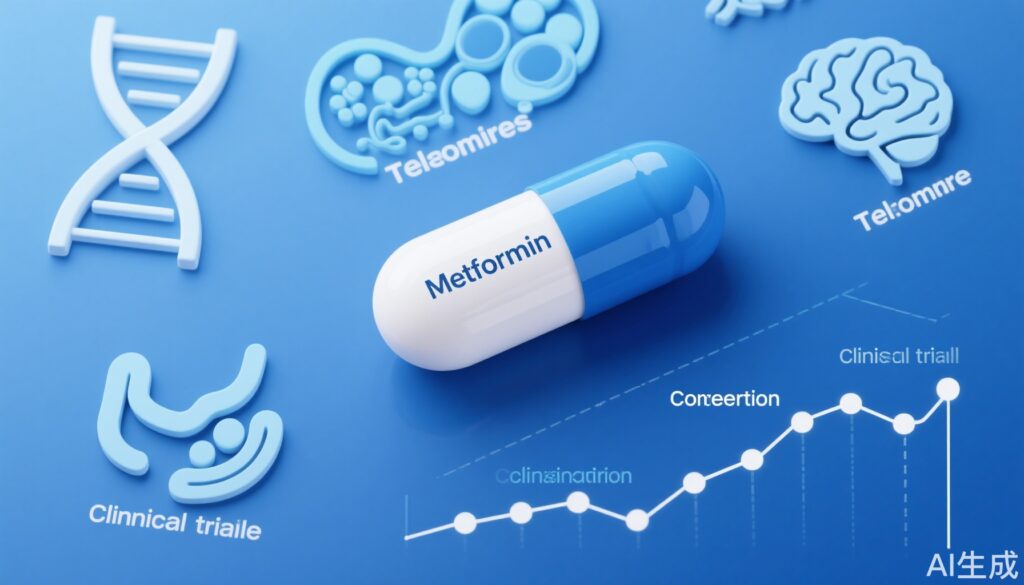Highlights
– Large randomized follow-up from the Diabetes Prevention Program found no statistically significant reduction in overall cancer incidence with metformin over 21 years (HR 0.90, 95% CI 0.73–1.10).
– Randomized perinatal and complementary animal studies show no effect of metformin on placental ageing markers (telomere length, methylation, histology).
– Metformin did not change IgG GlycanAge index in a middle‑aged male cohort, whereas testosterone did; suggesting limited impact of metformin on this biomarker of biological age.
– Metformin is associated with reproducible changes in the gut microbiome (notably Akkermansia muciniphila enrichment) and plasma metabolites; in two cohorts this microbiome/metabolite signature correlated with better memory performance in men.
Study background and disease burden
Interest in repurposing metformin as a gerotherapeutic stems from epidemiologic signals linking metformin exposure to lower all‑cause mortality and cancer incidence in people with diabetes, extensive preclinical data (AMPK activation, mTOR inhibition, reduced senescence, altered mitochondrial function), and an exceptional safety record in broad clinical use. Aging biology is associated with increased incidence of cancer, neurodegenerative disease, and multi‑morbid decline. A safe, inexpensive pharmacologic agent that slows biologic aging could have major public‑health impact. But observational data are vulnerable to confounding by indication, healthy user effects, and differences in comorbidity. High‑quality randomized evidence is required to determine whether metformin produces clinically meaningful anti‑aging effects in humans and to define which endpoints (incidence of major age‑related disease, validated biomarkers of biological age, cognition) respond to treatment.
Study designs summarized
The recent body of work summarized here includes randomized long‑term and mechanistic trials as well as observational cohort analyses:
– Diabetes Prevention Program (DPP) long‑term follow‑up (Heckman‑Stoddard et al., Cancer Prev Res 2025): randomized 3,234 adults at high diabetes risk to intensive lifestyle (ILS), metformin 850 mg twice daily, or blinded placebo (1996–2001) with median 21 years follow‑up; primary endpoint in this analysis: incident total cancer adjudicated from medical records.
– Placental ageing study (Hattersley et al., J Physiol 2025): randomized trial of metformin versus placebo in pregnant women with BMI ≥30 kg/m2; evaluated placental ageing by telomere length, histology, gene expression and methylation, with complementary in vitro trophoblast and mouse model experiments.
– GlycanAge/IgG glycome study (Vinicki et al., Geroscience 2025): randomized trial arms including metformin, testosterone, combination, and placebo in European white men aged 29–45 years (NCT02514629); assessed changes in IgG glycosylation and GlycanAge index over time.
– Microbiome/metabolome and cognition analysis (Rosell‑Díaz et al., Metabolism 2024): combined observational Aging Imageomics cohort and a randomized pilot (MEIFLO) to compare metformin‑treated type 2 diabetes (T2D) subjects versus non‑metformin groups and healthy controls; shotgun metagenomics and plasma metabolomics were analyzed in relation to cognitive test scores.
Key findings
Randomized cancer incidence (DPP follow‑up)
– After median 21 years, 546 first incident cancers occurred (173 metformin, 182 ILS, 191 placebo). Incidence rates per 1,000 person‑years: 9.8 (metformin), 10.5 (ILS), 10.8 (placebo).
– Hazard ratio (HR) for metformin vs placebo: 0.90 (95% CI 0.73–1.10); for ILS vs placebo: 0.96 (95% CI 0.79–1.18). No statistically significant differences were observed for total cancer, obesity‑related cancers, or in sex‑specific analyses.
– Interpretation: In this large randomized cohort at high diabetes risk, assignment to metformin 850 mg twice daily did not significantly reduce long‑term cancer incidence versus placebo. The trial authors note potential dilution of effects due to nonstudy metformin use over time (because participants developed diabetes) and diminishing intensity of lifestyle intervention after the trial phase.
Placental ageing (human, in vitro, mouse)
– In 105 placentas from randomized pregnant participants, metformin exposure produced no differences in telomere length, histologic markers (fibrosis, calcification), gene expression arrays, or methylation profiles compared with placebo.
– Complementary in vitro trophoblast experiments and mouse models showed no enrichment of classical senescence pathways with metformin treatment.
– Interpretation: These randomized and translational data provide reassurance regarding the lack of deleterious acceleration of placental ageing with metformin in obese pregnant women, but provide no support for metformin as a clinical intervention to decelerate placental senescence or prevent associated obstetric complications in non‑diabetic women.
IgG glycome / GlycanAge index
– In a cohort of white European men aged 29–45 years, testosterone treatment altered IgG glycosylation (decreased agalactosylation, increased galactosylation and sialylation) and the GlycanAge biomarker, but metformin did not produce statistically significant changes in IgG glycan patterns.
– Interpretation: Metformin did not modify this particular biomarker of biological age in this relatively young male cohort, suggesting limited impact on IgG‑glycosylation–derived measures of biological aging over the timeframe studied.
Gut microbiome, metabolome, and cognition
– Metformin use was reproducibly associated with compositional shifts in gut microbiota: enrichment of Akkermansia muciniphila and Escherichia coli and depletion of certain Firmicutes (Romboutsia spp.).
– Pathway analyses indicated upregulation of microbial pathways relating to the TCA cycle, butanoate, arginine, and proline metabolism; corresponding plasma metabolomics showed associations with proline.
– Cognitive associations were sex‑specific: in men, a higher A. muciniphila / R. ilealis ratio correlated with better memory scores; this was not observed in pooled analyses without sex stratification.
– Interpretation: These data support a biologically plausible gut microbiome–metabolite–brain axis for some cognitive benefits of metformin in men with T2D but are associative and require replication and mechanistic validation.
Safety signals and adverse effects
– The reviewed randomized trials did not identify novel safety concerns for metformin in the studied contexts; placental data were reassuring. Known adverse effects (gastrointestinal intolerance, risk of vitamin B12 deficiency with long‑term use, rare lactic acidosis in renal impairment) remain the relevant clinical considerations when contemplating metformin use.
Expert commentary and mechanistic considerations
– Mechanistic plausibility for geroprotection: metformin affects mitochondrial complex I, activates AMPK, downregulates mTOR signaling, reduces insulin/IGF‑1 axis signaling, and can decrease cellular senescence in some preclinical models. These actions plausibly modulate pathways of aging across tissues.
– Discordance between preclinical signals and human outcomes: The DPP cancer analysis and placental trial exemplify a common translational gap: promising mechanisms and observational associations do not consistently translate into clear clinical benefit on hard endpoints in randomized trials. Factors include differences in dose, timing (midlife vs late), population (diabetic vs non‑diabetic), duration of exposure, and endpoint selection.
– Biomarkers vs clinical endpoints: Lack of change in GlycanAge and placental senescence markers does not exclude effects in other tissues or with longer exposures; conversely, biomarker changes without clinical benefit would be insufficient to justify widespread preventive use.
– Heterogeneity and sex effects: The microbiome‑cognition analyses highlight possible sex‑specific responses; sex, age, baseline metabolic status and microbiome composition may modify responses to metformin and warrant stratified analyses in future trials.
– Policy and practice perspective: At present, metformin remains indicated for glycemic control and diabetes prevention in selected high‑risk individuals; off‑label use solely for anti‑aging is not supported by randomized clinical evidence and should remain within clinical trials until robust efficacy and safety are demonstrated.
Limitations of the current evidence base
– Many positive signals come from observational data vulnerable to confounding.
– Randomized trials to date have targeted diverse populations (pregnant women with obesity, adults at high diabetes risk, middle‑aged men) with different doses and durations, limiting generalizability.
– Biomarker studies may not capture tissue‑specific or long‑term clinically meaningful effects.
– Microbiome associations are correlative; causal mediation remains unproven.
Conclusions and research priorities
– Summary: Recent high‑quality randomized and mechanistic studies temper enthusiasm for metformin as a universal anti‑aging ‘miracle’ drug. Large randomized follow‑up from the DPP showed no significant reduction in total cancer incidence with metformin over 21 years; randomized perinatal and biomarker studies found no evidence that metformin slows placental ageing or modifies the IgG GlycanAge index in the cohorts studied. However, reproducible microbiome and metabolomic changes associated with metformin — and their correlation with improved memory performance in men — identify plausible pathways meriting further study.
– Clinical takeaway: Metformin should not be prescribed for anti‑aging in routine practice outside trials. Clinicians can reassure pregnant patients that randomized data do not indicate accelerated placental ageing from metformin and should continue to monitor standard safety parameters (renal function, B12 status) in long‑term users.
– Research agenda: well‑powered randomized trials in older, non‑diabetic adults with prespecified geriatric endpoints (cognitive decline, incident multimorbidity, validated composite biologic age measures), longer exposure durations, sex‑stratified analyses, integrated microbiome/metabolome profiling, and mechanistic substudies are needed. Harmonized biomarker panels and standardized endpoints will improve comparability across studies.
References
Heckman‑Stoddard BM, Crandall JP, Edelstein SL, Prorok PC, Dabelea D, Hamman R, Hazuda HP, Horton E, Hoskin MA, Perloff M, Bowers A, Knowler WC, Ford LG, Temprosa M; DPP Research Group. Randomized Study of Metformin and Intensive Lifestyle Intervention on Cancer Incidence over 21 Years of Follow‑up in the Diabetes Prevention Program. Cancer Prev Res (Phila). 2025 Jul 1;18(7):401‑411. doi: 10.1158/1940‑6207.CAPR‑23‑0461. PMID: 40243198 IF: 2.6 Q3 ; PMCID: PMC12213222 IF: 2.6 Q3 .
Hattersley GJ, Yang L, Tarry‑Adkins JL, Hufnagel A, Wong KK, Fernandez‑Twinn DS, Chukanova M, Robinson IG, Drake AJ, Reynolds RM, Ozanne SE, Aiken CE. The impact of metformin on placental ageing in humans and mice. J Physiol. 2025 Jun;603(11):3463‑3477. doi: 10.1113/JP288710 IF: 4.4 Q1 . Epub 2025 May 31. PMID: 40448705 IF: 4.4 Q1 ; PMCID: PMC12148204 IF: 4.4 Q1 .
Vinicki M, Pribić T, Vučković F, Frkatović‑Hodžić A, Plaza‑Andrades I, Tinahones F, Raffaele J, Fernández‑García JC, Lauc G. Effects of testosterone and metformin on the GlycanAge index of biological age and the composition of the IgG glycome. Geroscience. 2025 Apr;47(2):1777‑1788. doi: 10.1007/s11357‑024‑01349‑z. Epub 2024 Oct 4. PMID: 39363095 IF: 5.4 Q1 ; PMCID: PMC11979073 IF: 5.4 Q1 .
Rosell‑Díaz M, Petit‑Gay A, Molas‑Prat C, Gallardo‑Nuell L, Ramió‑Torrentà L, Garre‑Olmo J, Pérez‑Brocal V, Moya A, Jové M, Pamplona R, Puig J, Ramos R, Bäckhed F, Mayneris‑Perxachs J, Fernández‑Real JM. Metformin‑induced changes in the gut microbiome and plasma metabolome are associated with cognition in men. Metabolism. 2024 Aug;157:155941. doi: 10.1016/j.metabol.2024.155941 IF: 11.9 Q1 . Epub 2024 Jun 12. PMID: 38871078 IF: 11.9 Q1 .



